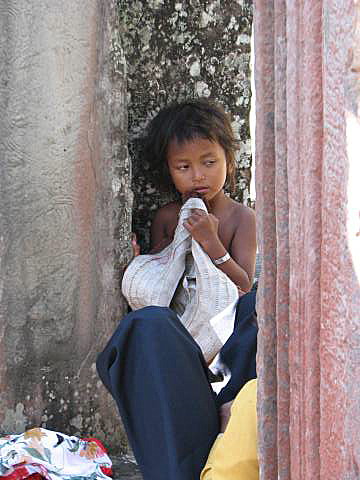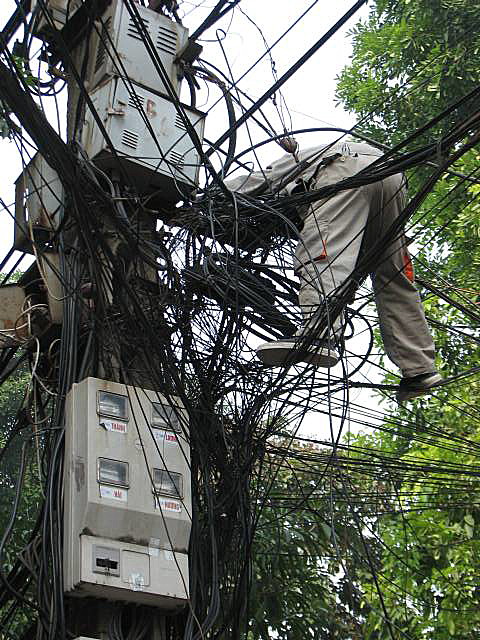| |
| Cambodian child at Angkor
|
|---|

| |
Perhaps a few notes on the region are in order.
People drive on the right in Cambodia, Laos and Vietnam; but on the left in
Singapore (and, if I remember rightly, Malaysia and Thailand).
There are many similarities in the culture and society of Cambodia, Laos
and Vietnam; and then there are differences, genetic and cultural, between
peoples within each nation.
An interesting part of polite behaviour in Cambodia, Laos and Vietnam is
in how one should pass something to, or accept something from, other people.
One should use both hands.
It is not necessary to hold onto the object with both hands, but the hand
that is not grasping the object should at least be touching the other arm.
This behaviour is considered more important in a young person passing
something to (or acceptiong something from) an older person; less important
in the older person.
It is a mark of respect to the other person.
In fact the local people make allowance for foreigners; they don't expect it
from foreigners, and often do not bother using both hands themselves when
interacting with foreigners.
Who are we?
My wife, Denece, and I were in our late sixties and early seventies at the
time of the visit.
Younger people would want to do more active things, of which there were
plenty: canioning, hiking, etc.
What we enjoyed as much as anything was sitting, sipping a coffee or eating
a good meal and watching the local people and observing their culture.
I am an early riser.
When on holiday or any other time I usually get out of bed as soon as I
notice daylight, if not before.
In most places this means that I am one of the very few Caucasians out and
about; in Seam Reap this was not so because many made the effort to rise
early to see Angkor Wat at sunrise.
|
|
| SE Asian electrical wiring
|
|---|

| | This example, more chaotic than average, was in Hanoi,
Vietnam
| |
In most places it is possible to travel by organised tours.
You can probably arrange all your trip before you leave home; we did not.
All that we had booked when we left home was our flights to and from
Vietnam (into and out of Ho Chi Minh = Saigon), a connecting flight from
Saigon to Siem Reap, a hotel in Siem Reap (it's no fun arriving in a strange
place late in the day and having to find a hotel), flights from
Siem Reap to Luang Prabang and from Luang Prabang to Hanoi; the remainder
we organised as we went along.
Visibility is often limited by smog in SE Asia.
It does vary from place to place and time to time, but if you can see more
than ten kilometres at any time consider yourslelf lucky.
Coming from Australia, where it is not unusual for visibility to be more
than fifty kilometres, Denece and I found this disapointing.
Probably the worst visibility on our trip was at Hanoi and the first few
days at Ninh Binh.
I remember on a previous trip to Hoi An visibility was so bad that the
Sun could not be seen until it was twenty or more degrees above the
horizon.
One change since our last visit to the region (in 2008) that Denece and I
noticed was the greatly increased use of mobile phones.
The photo on the right was taken in Singapore (waiting for one of the
underground trains); note that all three people in the foreground are
using mobile phones, when we were sitting in a train later we noticed
that six out of seven people in a particular line of seats were all using
mobile phones at one time.
There was not so much use of mobiles in the other three countries, but still
a remarkably large amount of use.
Not only did city business people carry and frequently use mobile phones,
but even tuk-tuk drivers and small farmers in the country.
Formally, and in law, I believe women and men have the same rights; but in
practice women seem to be expected to work longer and more consistantly
than men.
Particularly in Vietnam one often sees men sitting around in coffee shops or
cafes; it is much more unusual to see women doing nothing.
Having seen only one place in each of Cambodia and Laos all I can
say about those two countries is that visitors will do well to visit
Siem Reap in Cambodia and
Luang Prabang in Laos.
I feel more able to advise on what to see in Vietnam, having visited quite a
few places and travelled by road or rail almost the whole length of the
country.
Obviously on the must-see list is
Halong Bay, but if you want to see
similar karst topography in an area not quite so dominated by tourism the
Ninh Binh area is the place to go.
Also at Ninh Binh a must see is the huge new Buddhist temple of
Bai Dinh.
In the vicinity of Ninh Binh, but also not a long way from Hanoi, is the
beautiful rural
Phu Luong area, where
you can get right away from Western tourists.
(One place, there must be others, where visits to Phu Luong can be organised
is at Xuan Hoa Hotel, Ninh Binh.)
Very touristy, but still very worth-while is
Hoi An; great for tailor-made clothes and
shoes as well as being a fascinating historical city.
A boat and bus tour of the
Mekong Delta shows a part of Vietnam
that will be, with the Red River Delta, at great risk with the rising sea
levels that will come with climate change.
Under-rated, but certainly worth a short visit are
Quy Nhon and
Danang.
Finally, one of our favourites is
Dalat, at 1500m altitude, is a great place to
relax in the relative cool of the Southern Highlands.
In Dalat, at the end of the cable car ride, is the beautiful
Thien Vuong Pagoda and gardens.

